Dirac and Squeezed States
Paul A. M. developed the concept of squeezed states in two different ways.- Space-time Squeeze. By introducing his light cone coordinate system
he observed that the Lorentz boost is a squeeze transformation.
- Two-photon States. By constructing an algebra for two coupled
harmonic oscillators, he worked out the symmetry of two-photon
states.
Let us discuss these issues in detail.
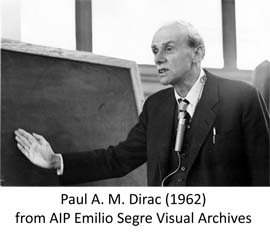
|
1. Space-time Squeeze
- According to Einstein's special relativity, Lorentz boosts leave
-
z2 - t2
invariant. In 1949 [ Rev. Mod. Phys. 21 , 392 (1949)], Dirac noted that this quantity can be written as
-
(z + t)(z - t) = constant.
- Earlier in 1927 [Proc. Roy. Soc. (London) A114, 243],
Dirac pointed out there is an uncertainty
relation between time and energy variables. Unlike Heisenberg's
uncertainty, there are no excitations along the time axis. Dirac
called it the c-number time-energy uncertainty relation.
- In 1945 [Proc. Roy. Soc. (London) A183 , 284],
Dirac attempted to use harmonic oscillators to construct
representations of the Lorentz group. However, he did not give
a physical interpretation to the time variable appearing his
Gaussian Gaussian form.
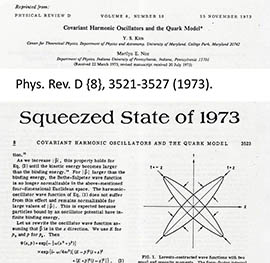
-
In 1971, Feynman and his students observed that that observed hadronic
mass spectra can be interpreted in terms of three-dimensional harmonic
oscillators. However, they fail to construct Lorentz-covariant wave
functions. For instance, they choose to ignore the time variable in
the wave function simply because they do not know how to handle it.
This is not the right way to do physics.
-
In 1973, Kim and Noz noted that Yukawa in 1953 had constructed the
normalizable oscillator wave functions, and discuss the calculation
of the of the proton form factor by Fujimura, Kobayashi, and Namiki
who obtained the dipole cutoff of the form factor.
- Indeed, it is possible to combine Dirac's idea and Feynman's idea to solve some of the outstanding problems in high-energy physics. Click here for a story.
|
|
2. Dirac's Two-photon States
- In 1963
[
J. Math. Phys. 4 , 901 (1963) ], Dirac published a paper
containing ten bilinear combinations of the step-up and step-down
operators. Click here for their expressions.
- Dirac noted that these operators satisfy the commutations relations
for the generators of the O(3,2) de Sitter group, which is the
Lorentz group applicable to the three space dimensions and two
time dimensions.
- Dirac acknowledged in his paper that he was told by a younger
physicist that those ten bilinear forms can also serve as the generators of
the four-dimension symplectic group applicable to the phase space
consisting of two coordinate and two momentum variables.
- I realized that Dirac was working on this 1963 paper when I had an audience with him in 1962. He was talking about his paper at that time.
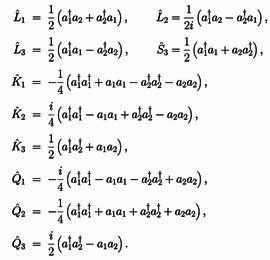
Formulas from Dirac's 1963 paper - Dirac noted that these operators satisfy the commutations relations
for the generators of the O(3,2) de Sitter group, which is the
Lorentz group applicable to the three space dimensions and two
time dimensions.
- Realizing that I was interested in squeezed states in optics,
John Klauder
sent me five copies of the paper he published with Yurke and MacCall
in
Phys. Rev. A. (1986), containing five of the ten generators
given in Dirac's 1963 paper. After studying his paper, I started
saying Paul A. M. Dirac invented squeezed states. Did you know?
Don't forget Dirac's space-time squeeze as described before.
- I met John Klauder when I went to Princeton in 1958. He had been
Wheeler's student and received his degree in 1959. He has been
very helpful to me especially whenever I needed his help.
Many other friends of mine ran away from me when I needed them. You
must have gone through the same experience if you lived long enough.
Here is a photo of myself talking to him in 1986. In this photo of 1994, John Klauder is negotiating with the residents of Nara's Deer Park in Japan.
-
During the period 1985-90, my job was to compose the stories
Eugene Wigner wanted to hear. I was able to translate
Dirac's 1963 on squeezed states into the language of Wigner
functions.
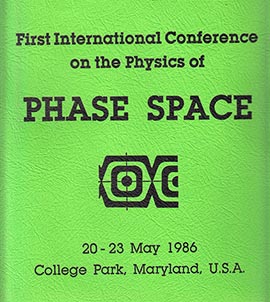
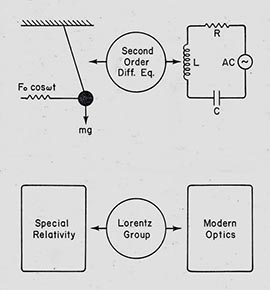
- In order to learn more about the Wigner function, I organized in
1986 a conference on the physics of phase space. Wigner came.
Klauder came. So did many VIPs in the field, including Marlan
Scully, Wolfgang Schleich, and John A. Wheeler. This conference
served as the prelude to the international conference series now
known as ICSSUR.

- I met John Klauder when I went to Princeton in 1958. He had been
Wheeler's student and received his degree in 1959. He has been
very helpful to me especially whenever I needed his help.
Many other friends of mine ran away from me when I needed them. You
must have gone through the same experience if you lived long enough.
- Squeeze transformations play important roles also in understanding
the two-by-two ABCD matrix. I enjoyed writing many papers on the
ABCD matrices applicable to optical periodic systems including
cavity optics, multilayer optics, as well as lens optics.
- These optical processes can be described by the Lorentz group.
More specifically, they contain the symmetry contents of
Wigner's little groups dictating internal space-time symmetries
in the Lorentz-covariant world.
- Poincaré constructed his sphere in order to study polarization optics. Did you know that this sphere also contains the group theoretical contents of Dirac's 1963 paper on the squeezed state?
- These optical processes can be described by the Lorentz group.
More specifically, they contain the symmetry contents of
Wigner's little groups dictating internal space-time symmetries
in the Lorentz-covariant world.
- Indeed, it was a rewarding experience for me to study the
internal space-time symmetries of particles
while writing papers in optical sciences.
- Toyotomi Hideyosi is a very important person in Japanese history.
In 1600, he unified his country, but Japan was too small for him. He
thus appointed himself as the emperor of China. From his point of
view at that time, China was the center of the world. He sent 150,000
Samurai troops to the Korean peninsula to make his
way to go to Beijing for his coronation. The story could be
very long, but let me stop here.
- Toyotomi was such an unusual character that there are in Japan
many stories about him. He apparently was not a handsome person.
Thus, he is a monkey to human eyes. He is a human if monkeys look at him. You have not seen this photo, but you have seen many photos of the Osaka Castle. He built this castle, and he lived there.
- Likewise, I am an optics man to particle physicists, while I am a high-energy man to optical physicists.
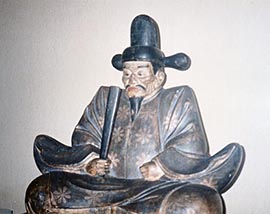
He built this castle in Osaka,
and lived there.
- Toyotomi Hideyosi is a very important person in Japanese history.
In 1600, he unified his country, but Japan was too small for him. He
thus appointed himself as the emperor of China. From his point of
view at that time, China was the center of the world. He sent 150,000
Samurai troops to the Korean peninsula to make his
way to go to Beijing for his coronation. The story could be
very long, but let me stop here.
- I seem to like Dirac.
Click here to see how much I like him. You will be interested in
the following pages.
- Continuation of this page
- Dirac and Feynman
- Dirac as a poet
- Dirac's Lorentz covariance
- Dirac's Permutations
- Dirac in Poland
- and More
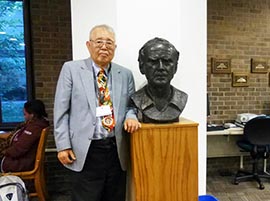
Dirac's bust in
Princeton's Fine Hall Library.
I talked with him in 1962 and in 1978. - Continuation of this page
- I see rooms for squeezed in condensed matter physics. If you have ideas along this direction, let me know. Send me an email to me at yskim@umd.edu. We can work together. Squeeze transformations are everywhere in physics.
- copyright@2015 by Y. S. Kim, unless otherwise specified.
- Here is his home page.
- Here is Einstein page.
- Here is Dirac page
- Here is Style page.
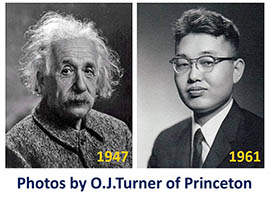
|
| Who is this young man? |